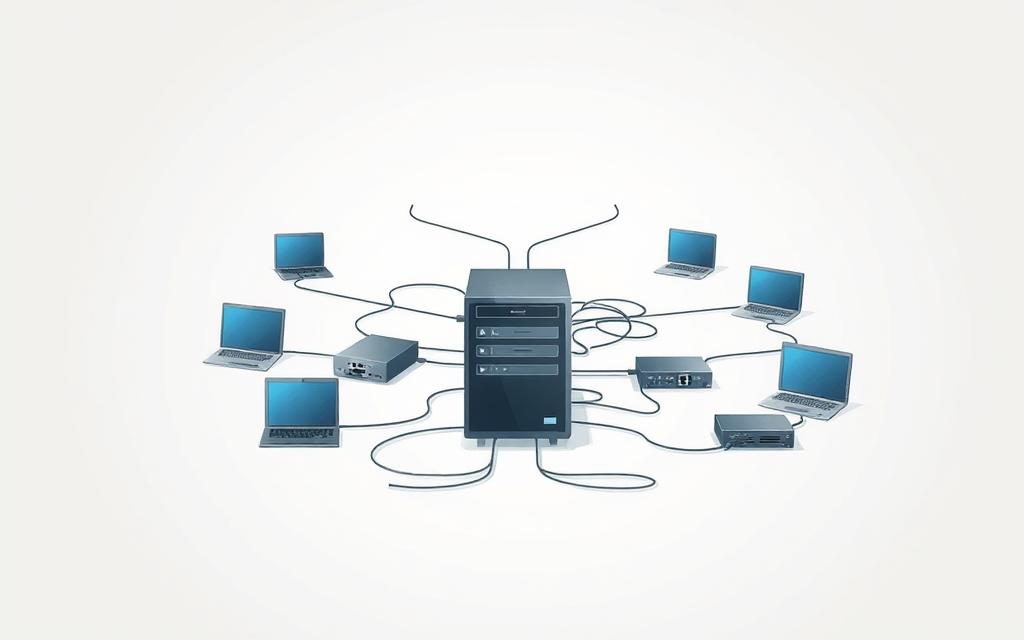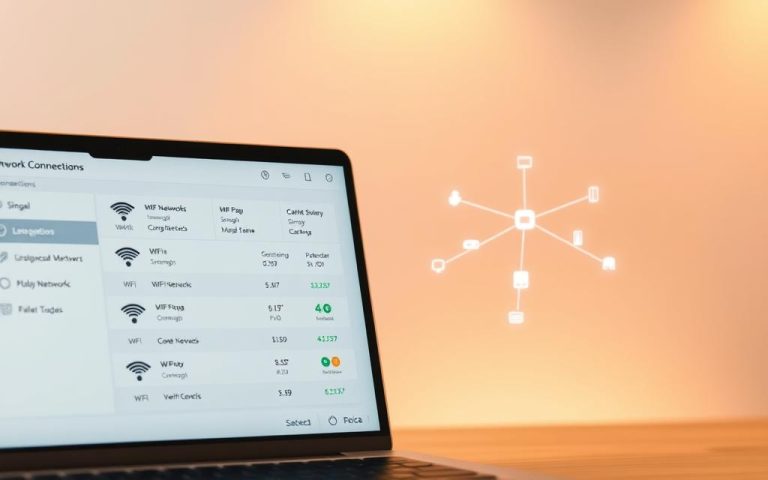Understanding Network Computers: A Simple Guide
Modern businesses rely on interconnected systems to share data and resources efficiently. These setups, often called computer networks, power everything from cloud collaboration to real-time traffic monitoring. Their origins trace back to ARPANET, a military project from the late 1960s.
Today, 93% of enterprises use cloud-based setups for seamless operations. Tools like Google Drive and video conferencing platforms showcase how far networks have evolved. They enable instant communication, secure file sharing, and global teamwork.
Key components like routers, switches, and protocols ensure smooth connectivity. Emerging trends, such as IoT and 5G, continue to reshape how devices interact. Understanding these fundamentals is essential for professionals navigating today’s digital landscape.
What Is a Network Computer?
Interconnected systems form the backbone of digital communication, allowing devices to exchange information effortlessly. These setups enable seamless collaboration across industries, from healthcare to finance.
Core Concepts and Operations
A system linking multiple devices creates pathways for data flow. Two primary architectures dominate modern setups:
- Client-server models: Centralized hubs manage requests from connected endpoints
- Peer-to-peer configurations: Direct exchanges between equal participants
Protocols like TCP/IP govern how computing devices communicate. Standardized rules ensure compatibility across different platforms and manufacturers.
From ARPANET to Modern Clouds
The late 1960s witnessed the birth of networked systems with ARPANET’s four-node connection. Key milestones transformed these early experiments:
- 1971: First electronic mail transmission
- 1983: TCP/IP protocol standardization
- 1997: Wireless networking breakthroughs
Physical connections evolved from bulky coaxial cables to today’s fiber optics. Modern implementations leverage wireless technologies, enabling mobile access to shared resources.
Security measures progressed from simple passwords to advanced encryption. Multi-factor authentication now protects sensitive information across global networks.
Emerging technologies like quantum encryption promise faster, more secure data transfers. Edge computing brings processing power closer to end-users, reducing latency for critical applications.
Key Components of a Computer Network
Robust digital ecosystems are built using routers, cables, and communication guidelines. These components work together to transmit data reliably across homes and enterprises.

Network Devices: Nodes and Endpoints
Every setup requires hardware to send and receive information. Essential network devices include:
- Routers: Direct traffic between different systems
- Switches: Connect multiple devices within a local setup
- NICs: Enable physical or wireless links to endpoints
Links: Wired and Wireless Connections
Speed and stability vary by connection type. Compare popular options:
| Type | Speed | Use Case |
|---|---|---|
| Fiber optics | 70% light speed | Enterprise backbones |
| WiFi 6 | 9.6 Gbps | High-density offices |
| 5G cellular | 1–10 Gbps | Mobile access |
Communication Protocols: Rules for Data Exchange
Standardized protocols like TCP/IP govern 95% of internet traffic. Common examples:
- HTTP/HTTPS: Secures web browsing
- FTP: Manages file transfers
- SMTP: Routes emails between servers
Emerging standards like WiFi 7 promise lower latency for AR/VR applications. Choosing the right infrastructure ensures scalability and security.
Types of Computer Networks
Organizations and individuals use different setups to meet specific connectivity needs. Choosing the right type ensures efficient data flow, security, and resource accessibility.
Local Area Network vs. Wide Area Network
Local area networks (LANs) cover small spaces like offices or homes. They enable shared access to printers, files, and applications within a limited zone.
Wide area networks (WANs) connect multiple locations across cities or countries. Internet service providers and global corporations rely on these expansive systems.
| Feature | LAN | WAN |
|---|---|---|
| Coverage | ≤1 km | Unlimited |
| Speed | 1–10 Gbps | 10 Mbps–1 Gbps |
| Cost | Low | High |
| Use Case | Single building | Multi-site operations |
Specialized Network Solutions
Storage area networks (SANs) optimize data centers with 40% cost reductions. Enterprises use them for high-speed access to consolidated storage.
Personal area networks link devices like smartphones and wearables via Bluetooth. Metropolitan area networks power city-wide systems with 99.999% uptime.
- Hybrid setups combine SD-WAN flexibility with MPLS reliability
- Emerging self-healing technologies minimize WAN disruptions
- Fiber-optic backbones support high-bandwidth MAN applications
For deeper insights on infrastructure choices, explore this network fundamentals guide.
How Computer Networks Work
Behind every online activity lies a sophisticated system of protocols and connections. These systems break down data, route it efficiently, and ensure seamless communication across devices.

Data Transmission and Packet Switching
Information travels in small chunks called packets (average size: 1,500 bytes). Unlike old phone systems that used dedicated lines, modern packet switching routes each piece independently for efficiency.
Key differences:
- Packet switching: Dynamic paths, better for internet traffic
- Circuit switching: Fixed paths (e.g., traditional landlines)
TCP/IP ensures reliability with a three-step handshake:
- Device A sends a “sync” request
- Device B acknowledges and syncs
- Device A confirms—data transfer begins
Role of IP Addresses and DNS
Every device needs a unique identifier. IPv4 uses 32-bit addresses (e.g., 192.168.1.1), while IPv6 (now 40% adopted) offers 128-bit for limitless scalability.
| Version | Format | Address Space |
|---|---|---|
| IPv4 | 192.168.1.1 | 4.3 billion |
| IPv6 | 2001:0db8:85a3:: | 340 undecillion |
DNS acts like a phonebook, translating “google.com” to an IP in under 50ms. The hierarchy flows from root servers to specialized routers.
Home networks use NAT to share one public IP across multiple devices. Tools like Ping and Wireshark help diagnose traffic issues, while QoS prioritizes video calls over less urgent data.
Benefits of Using a Computer Network
Efficient connectivity solutions transform how teams operate daily. By linking devices and systems, organizations unlock productivity gains, cost savings, and streamlined workflows. These advantages span industries, from healthcare to finance.

Resource Sharing and Cost Efficiency
Centralized setups eliminate redundant hardware. For example, one networked printer serves an entire office, reducing purchase and maintenance costs by up to 40%.
Cloud-based service models cut IT expenses by 35%, according to AWS. Virtualization minimizes energy use, while shared storage simplifies backups and management.
| Resource | Savings | Use Case |
|---|---|---|
| Printers | 40% lower costs | 50-employee offices |
| Cloud storage | 35% less vs. on-premise | Remote teams |
| VPNs | 400% adoption growth | Secure remote access |
Enhanced Communication and Collaboration
Real-time tools like Slack and MS Teams boost teamwork. Employees save 2.5 hours weekly by avoiding email delays, as noted in a network efficiency study.
Unified platforms also strengthen security. Features like end-to-end encryption help meet HIPAA and GDPR standards, protecting sensitive data during exchanges.
- Disaster recovery: Automated backups ensure continuity during outages
- Scalability: Modular designs support growth without overhauls
- Remote access: VPNs enable secure logins from any location
Network Topologies: Design and Structure
Strategic arrangement of nodes defines how systems exchange information. Choosing the right network topology impacts performance, reliability, and scalability. Businesses leverage these blueprints to optimize connections and minimize downtime.

Star, Ring, and Bus Topologies
Star topology dominates 80% of offices due to its simplicity. Each node links to a central hub, isolating faults for easier troubleshooting. However, hub failures disrupt all devices connected.
Ring topology suits industrial systems with bidirectional data flow. Nodes form a closed loop, but single-point failures halt operations. Token ring networks exemplify this layout.
Bus topology, once common in early Ethernet, uses a shared backbone cable. It’s cost-effective but struggles with scalability. Modern setups rarely adopt it due to collision risks.
Mesh and Hybrid Configurations
Full mesh networks interconnect all nodes for maximum redundancy. They cost 3× more than star setups but excel in IoT deployments where uptime is critical.
Hybrid topologies blend structures like star-mesh combinations. These reduce downtime by 60% and adapt to complex network infrastructure needs. For example:
| Topology | Pros | Cons | Best For |
|---|---|---|---|
| Star | Easy maintenance | Hub dependency | Small offices |
| Mesh | High reliability | Expensive | IoT, military |
| Hybrid | Balanced cost/performance | Complex setup | Enterprises |
Future-proofing strategies prioritize hybrid designs. Overlay networks, like SD-WAN, map logical connections over physical layouts for flexibility.
Best Practices for Network Management
Effective network management ensures smooth operations and protects critical assets. IT teams must balance robust security protocols with performance tweaks to maintain uptime and efficiency. Below are actionable strategies to optimize infrastructure.
Security Measures and Protocols
Regular updates prevent 85% of breaches, making patch management non-negotiable. Adopt these key tactics:
- Zero Trust Architecture: Verify every access request, even from internal users.
- Multi-factor authentication: Add layers like biometrics or SMS codes.
- Network segmentation: Isolate sensitive data to reduce attack surfaces by 70%.
Encrypt all traffic using TLS 1.3, and audit vendor tools quarterly for compliance gaps.
Performance Optimization Techniques
Monitoring tools improve uptime by 40%. Prioritize these optimizations:
| Tool | Function | Impact |
|---|---|---|
| Bandwidth monitors | Track congestion | Prevent bottlenecks |
| Load balancers | Distribute traffic | Boost server response |
| QoS settings | Prioritize VoIP/video | Reduce latency |
Automate backups and test disaster recovery plans biannually. Train staff quarterly on phishing risks to fortify human firewalls.
Conclusion
Future-ready infrastructures demand adaptive strategies. From LANs to cloud setups, choosing the right components ensures seamless data flow. Prioritize security-first designs with encryption and zero-trust frameworks.
AI-driven automation and 5G will redefine network management. AWS tools like VPC and Shield offer scalable solutions. Continuous learning keeps teams ahead in this dynamic field.
Investing in robust systems yields 40% cost savings and productivity gains. Audit your setup today to leverage these advantages. Explore AWS networking services for cutting-edge implementations.













